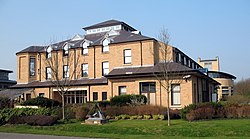Isaac Newton Institute

The Isaac Newton Institute for Mathematical Sciencesis an international research institute for mathematics and its many applications at theUniversity of Cambridge.It is named after one of the university's most illustrious figures, the mathematician and natural philosopherSir Isaac Newton,and occupies one of the buildings in the CambridgeCentre for Mathematical Sciences.
History[edit]
After a national competition run by SERC, the Science and Engineering Research Council (now known as EPSRCEngineering and Physical Sciences Research Council), this institute was chosen to be the national research institute for mathematical sciences in the UK.[1] It opened in 1992 with support fromSt John's CollegeandTrinity College.[1]St. John's provided the land and a purpose-built building, Trinity provided running costs for the first five years and theLondon Mathematical Societyprovided other support.[1]
Shortly afterwards at the institute, the British mathematicianAndrew Wilesannounced his approach to provingFermat's Last Theoremin three lectures on 21–23 June 1993.[2]In 1999 the institute was awarded a Queen's Anniversary Prize in recognition of "world-class achievement in education." Although it is part of the national infrastructure for mathematical research, it is formally part of theUniversity of Cambridge,from which it receives some funding. Nowadays five UK Research Councils, BBSRC, EPSRC, ESRC, NERC, STFC support about 55% of its activity. A number of philanthropic individuals, family and educational trusts, private companies and bodies associated with theUniversity of Cambridgegenerously give their support.[1]
Scientific programmes[edit]
There are typically two or three programmes at any one time, each with up to twenty people and lasting between 4 weeks and 6 months.[3]During these periods of activity there are courses and workshops for the attendees.[4]
Programmes are chosen from proposals that cover the entire range of mathematical sciences and their applications by a Scientific Steering Committee of mathematical scientists solely on their scientific merit and the likelihood that they will have significant impact in their subject.[3]
Although programmes are normally residential and planned several years ahead, during theCOVID-19 pandemic,an urgent 6-workshop virtual programme on the Infectious Dynamics of Pandemics was approved and ran from April to September 2020. This was a successor to a 2013 programme on Infectious Disease Dynamics, and was complemented by virtual study groups and commissioned modelling for government.[5]
Directors[edit]
- 1991–1996 SirMichael AtiyahOM FRS
- 1996–2001Keith MoffattFRS
- 2001–2006 SirJohn KingmanFRS
- 2006–2011 SirDavid WallaceCBE FRS
- 2011–2016John TolandFRS
- 2016–2021David Abrahams
- 2021–Ulrike TillmannFRS
The institute is chaired by technology entrepreneur and founder ofCantab Capital Partners,Ewan Kirk.
See also[edit]
References[edit]
- ^abcd"A Brief History of the Newton Institute".newton.ac.uk.Retrieved7 September2014.
- ^Gina Kolata (24 June 1993)."At Last, Shout of 'Eureka!' In Age-Old Math Mystery".The New York Times.Retrieved10 September2014.
- ^ab"Scientific Programmes".newton.ac.uk.Retrieved10 September2014.
- ^"The Isaac Newton Institute for Mathematical Sciences".ima.org.uk.Retrieved10 September2014.
- ^Dangerfield, CE (2023)."Getting the most out of maths: How to coordinate mathematical modelling research to support a pandemic, lessons learnt from three initiatives that were part of the COVID-19 response in the UK".Journal of Theoretical Biology(557).doi:10.1016/j.jtbi.2022.111332.
- ^"Welcome to Newton Gateway to Mathematics | Newton Gateway to Mathematics".gateway.newton.ac.uk.Retrieved15 March2019.
External links[edit]
- Official website
- Interactive mapof the Mathematical Sciences site including links to the departments.

